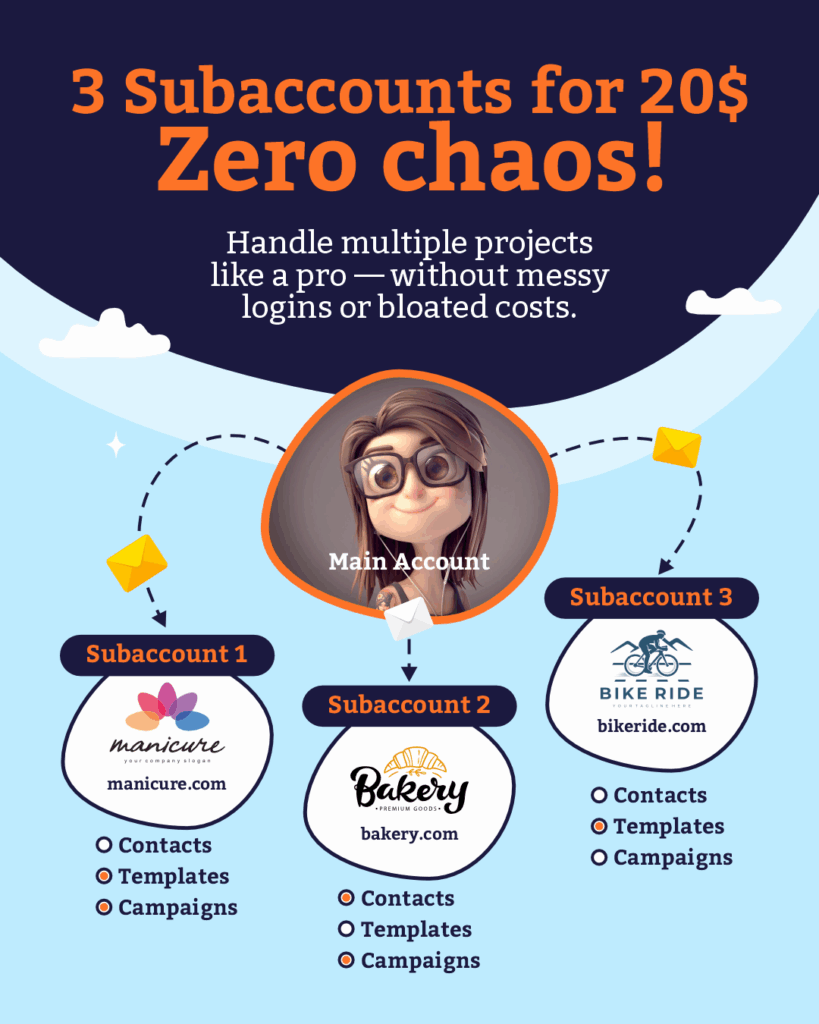If you’ve been in marketing for more than five minutes, you know this truth:
The tools that got you to 1,000 subscribers won’t get you to 10,000.
Not because they don’t work, but because they weren’t built to scale efficiently. You’ll hit invisible walls: pricing jumps, feature limitations, deliverability issues, or (worst of all) the chaos of managing multiple clients across different platforms.
I’ve watched countless marketers, agencies, and freelancers hit the same wall:
- Start small with a “beginner-friendly” platform.
- Grow your list (good news!).
- Watch your monthly bill explode (bad news).
- Realize you’re paying $200+ per month but have zero control over deliverability.
- Try to migrate to a new platform (nightmare fuel).
There’s a better way. And it’s not about finding the “perfect” tool: it’s about building a system that prioritizes efficiency, control, and predictability from day one.
Why Most Email Marketing Systems Fail to Scale
Before we talk solutions, let’s diagnose the problem. Based on conversations with hundreds of marketers and agencies, these are the four killers that prevent scaling:
1. The Contact-Based Pricing Trap
Traditional platforms like Mailchimp charge based on your list size. Sounds fair, right? Until you realize:
- You’re paying for inactive subscribers who haven’t opened an email in months.
- Your costs double when you hit the next pricing tier (even if you send the same number of emails).
- You’re financially penalized for list growth (the thing you’re supposed to be doing!).
The math gets ugly fast: 5,000 contacts with daily campaigns? That’s $100+ per month on Mailchimp. Have 50,000 contacts? You’re looking at $450+ per month (whether you email them once or every day).
For a detailed breakdown of how different pricing models work, check out our guide on Email Marketing Pricing Models: Contacts-Based vs Send-Based.
2. The Copywriting Bottleneck
Here’s what most marketers don’t realize: The hardest part of email marketing isn’t the strategy; it’s the actual writing.
Every campaign needs:
- A scroll-stopping subject line
- Compelling body copy that drives action
- A clear, conversion-focused CTA
- The right tone for your audience
Multiply that by 3 to 5 campaigns per week, across multiple clients, and suddenly you’re spending more time writing than strategizing.
Good copywriters are worth their weight in gold, but they’re not always available, affordable, or fast enough when you need to launch yesterday.
3. The Deliverability Black Box
You craft the perfect email. Hit send. And… it lands in spam.
Why? You have no idea. You’re on shared IP addresses with thousands of other users. Someone else’s poor sending practices tank your deliverability. Your email provider shrugs and says, “It’s complicated.”
You don’t own your infrastructure, so you can’t control your results.
4. The Multi-Client Management Mess
If you’re an agency or freelancer, this one hits hard:
- Juggling separate accounts for each client
- Manually tracking which list belongs to which campaign
- One wrong click sends Client A’s email to Client B’s list (cue panic attack)
- No consolidated reporting, just spreadsheet hell
Most platforms either don’t support multi-client workflows or charge enterprise-level prices for the privilege.
The Efficiency Framework: 4 Pillars of Scalable Email Marketing
Now for the good part. Here’s how to build an email system that scales without breaking your budget (or your sanity).
Pillar 1: Pay for What You Send, Not Who You Know
The smartest shift in email marketing economics is moving from contact-based pricing to send-based pricing.
Think about it: Why should you pay the same amount to store 10,000 contacts whether you email them once a month or once a day?
The new model works like this:
- Fixed platform cost (your “home base”)
- Variable sending cost based on actual email volume
- Zero penalty for list growth
- Zero penalty for sending frequency
Real-world example:
- Old model: $100/month for 5,000 contacts with daily sends
- New model: $20/month platform + ~$30/month for sends = $50/month total
That’s an 50% cost reduction for identical output.
But here’s the key: this only works if you maintain control over your sending infrastructure (more on that in Pillar 3).
Pillar 2: Eliminate the Copywriting Bottleneck with AI
“Use AI for copywriting” isn’t new advice. But most tools get it wrong.
You don’t need AI to write entire emails (that usually sounds robotic). You need AI to accelerate the hardest parts:
Subject Line Generation
- The blank cursor problem? Gone
- Get 5-10 variations in seconds
- A/B test different angles without the mental gymnastics
Body Copy Framework
- Describe your campaign goal in plain language
- Get a solid first draft that captures your intent
- Edit and refine rather than starting from scratch
CTA Optimization
- AI suggests action-driven language based on campaign type
- Conversion-focused recommendations grounded in data
- Multiple options to test and iterate
The result? What used to take 45 minutes now takes 10. You can focus on strategy instead of staring at a blinking cursor.
Learn more about how AI transforms content creation in How Nova Express Makes Marketing Text Creation Effortless.
Want to master copywriting fundamentals alongside AI tools? These guides teach you the principles that make AI suggestions even more effective:
Pillar 3: Own Your Deliverability
Here’s the uncomfortable truth: if you don’t control your sending infrastructure, you don’t control your results.
The solution? Direct integration with enterprise-grade delivery providers.
Instead of relying on a platform’s shared infrastructure, you connect directly to providers like:
- Amazon SES: $0.10 per 1,000 emails, enterprise reliability, full DNS control
- Mailgun: Advanced analytics, global infrastructure, competitive pricing
What this gives you:
- Your own sender reputation (no one else can tank it)
- Full control over SPF, DKIM, and DMARC records
- Transparent deliverability metrics
- Option for dedicated IP addresses
- Crystal clear cost visibility
Yes, there’s a slight learning curve (you’ll need to understand DNS records). But the payoff is massive: your emails actually reach the inbox.
For a complete walkthrough of setting up your infrastructure properly, see How to Start Your First Email Campaign: A Step-by-Step Guide for 2025.
Pillar 4: Master Multi-Client Management with Subaccounts
If you manage more than one client (or brand, or product line), this pillar is non-negotiable.
What you need:
- Complete data isolation between clients
- Separate contact lists, templates, and campaigns
- Individual reporting and analytics
- Seamless account switching
- Centralized billing and administration
What you don’t need:
- Separate platform subscriptions for each client
- Complex permissions systems
- Manual tracking spreadsheets
- Fear of sending the wrong email to the wrong list
Think of subaccounts like mini-accounts within your main account. Each client gets their own workspace: clean, secure, and completely separated from everyone else.
Real-world impact:
- Digital agency managing 8 clients: reduced admin time by 70%
- Freelancer with 3 active projects: eliminated cross-client confusion entirely
- Marketing consultant: now onboards new clients in under 10 minutes
Managing multiple clients effectively requires more than just organizational tools. You also need proper workflows, pricing strategies, and campaign templates that scale. For agencies specifically, these resources are essential:
- 🎯 Target Market: Trends and Analytics — Help each client find and understand their ideal audience
- 📊 10 Key Metrics to Analyze — Deliver data-driven reports that prove ROI
- ✍️ 9 Copywriting Tricks That Sell — Create high-converting campaigns faster for every client
For the complete guide to using subaccounts effectively, read Subaccounts: Made for Marketers Who Manage Multiple Clients.

Measuring What Matters: The Right Metrics for Scalable Email Marketing
Julia McCoy, who built SEMrush’s legendary content engine, had a saying:
“The best content doesn’t just rank; it converts.”
The same principle applies to email. You can have perfect open rates, but if people aren’t taking action, you’re not moving the needle.
Here are the metrics that actually matter when you’re scaling:
Primary Metrics (Check Every Campaign)
- Open Rate: Are people interested in your message?
- Click Through Rate: Are they engaged enough to act?
- Conversion Rate: Did they complete your goal?
Efficiency Metrics (Check Weekly/Monthly)
- Cost per Conversion: How much are you spending per result?
- List Growth Rate: Are you building momentum or stagnating?
- Unsubscribe Rate: Are you losing people faster than you’re gaining them?
Health Metrics (Check Monthly/Quarterly)
- Bounce Rate: Is your list quality declining?
- Spam Complaint Rate: Are you annoying your subscribers?
- Revenue per Subscriber: What’s your list actually worth?
The key is establishing baseline numbers for your industry and audience, then consistently working to improve them. Don’t chase arbitrary “best practice” benchmarks that may not apply to you.
Want the complete breakdown? Learn exactly how to track, interpret, and optimize each of these metrics: 10 Key Metrics to Analyze Your Email Campaigns. This guide includes industry benchmarks, common pitfalls, and actionable optimization tactics for every metric.
The Implementation Roadmap: From Setup to Scale
Theory is nice. Implementation is where results happen.
Here’s your step-by-step roadmap to building an efficient, scalable email marketing system in 30 days:
Phase 1: Foundation (Week 1)
- Choose a platform built for efficiency (flat-rate pricing, infrastructure control).
- Set up your email delivery provider (Amazon SES or Mailgun).
- Configure DNS records (SPF, DKIM, DMARC) for maximum deliverability.
- Import your first contact list or create opt-in forms.
Phase 2: First Campaign (Week 2)
- Choose a template or design from scratch.
- Use AI assistance to generate subject lines and draft copy.
- Refine the message to match your brand voice.
- Send to a test segment first.
- Monitor metrics and iterate based on results.
Pro tip: If this is your first welcome email, study Best Welcome Email Examples: 5 Proven Strategies to ensure you’re applying psychology-backed principles that convert on day one.
Phase 3: Systematization (Weeks 3–4)
- Create reusable templates for common campaign types.
- Document your process for consistency.
- Set up subaccounts if managing multiple clients.
- Establish baseline metrics for your campaigns.
- Schedule regular review and optimization sessions.
Phase 4: Scale (Month 2+)
- Increase send frequency as you refine your approach.
- Expand your list through lead magnets and opt-in incentives.
- Test different content angles and formats.
- Automate repetitive campaigns (welcome sequences, nurture flows).
- Track cost efficiency and adjust as needed.
Your costs stay flat. Your results don’t.
Common Mistakes (and How to Avoid Them)
Even with the right framework, there are pitfalls. Here are the biggest ones I’ve seen (and how to sidestep them):
Mistake 1: Optimizing for Opens Instead of Outcomes
The trap: chasing high open rates with clickbait subject lines.
The fix: Focus on relevance and value. It’s better to have 20% opens that convert than 40% opens that immediately bounce.
Mistake 2: Ignoring List Hygiene
The trap: Keeping every subscriber forever, even inactive ones.
The fix: Regularly remove unengaged contacts. Quality beats quantity every time. A smaller, engaged list performs better and costs less.
Learn more about keeping your list healthy and engaged: Build Email Customer Journeys That Convert shows you how to create re-engagement sequences that win back inactive subscribers before you remove them.
Mistake 3: Sending Without Testing
The trap: Launching campaigns without preview testing.
The fix: Always send test emails to yourself and check on multiple devices. Broken links and formatting issues kill conversions instantly.
Mistake 4: Treating Email as a Broadcast Channel
The trap: One-way communication with no engagement opportunities.
The fix: Encourage replies. Ask questions. Make your emails feel like conversations, not announcements.
Mistake 5: Waiting for Perfection
The trap: endlessly tweaking emails instead of launching.
The fix: Ship the 80% version. Learn from real results. Iterate quickly.
The Philosophy Behind Efficient Email Marketing
Before you implement everything, let’s zoom out.
Julia McCoy revolutionized content marketing at SEMrush with one simple principle:
“Create content that’s so useful, people would pay for it; then give it away for free.”
Apply that same mindset to email:
- Clarity beats cleverness: Your subscribers are busy. Say what you mean. Skip the puns and vague promises.
- Value beats volume: One excellent email beats five mediocre ones. Every single time.
- Action beats perfection: Done is better than perfect. Launch, learn, improve.
- Efficiency beats effort: Work smart, not hard. Use tools that amplify your impact, not drain your resources.
- Control beats convenience: Own your infrastructure. It’s worth the setup effort.
Google’s Gary Illyes has said repeatedly that the best content is content that genuinely helps people solve problems, not content designed to game algorithms.
The same applies to email. The best campaigns are the ones your subscribers look forward to because they consistently deliver value.
And remember efficiency is not about cutting corners. It is about maximizing impact.
Your Next Steps
You now have the framework. Here’s how to put it into action today:
If you’re just starting, start with the foundation. Pick a platform that won’t penalize you for growth. Set up your infrastructure properly from day one. Send your first campaign and learn from real data.
Need a complete beginner’s roadmap? Start here: How to Start Your First Email Campaign: A Step-by-Step Guide for 2025.
If you’re scaling, audit your current costs and compare them to what you could be paying with send-based pricing. If the math doesn’t make sense, it’s time to migrate. Don’t let sunk costs trap you in inefficiency.
If you’re managing multiple clients, implement subaccounts immediately. The time savings and risk reduction will pay for themselves in the first month.
If you’re hitting the copywriting wall, stop fighting it alone. Use AI to handle the heavy lifting on first drafts and subject lines. Save your creative energy for strategy and optimization.
The Bottom Line
Email marketing in 2025 isn’t about who has the biggest list or the fanciest automation.
It’s about efficiency: doing more with less, controlling what matters, and building systems that scale without scaling costs.
The marketers winning today are the ones who:
- Pay for sends, not contacts
- Own their deliverability
- Use AI to eliminate bottlenecks
- Manage complexity with smart architecture
Build your email system on these principles, and you’ll never worry about hitting another scaling wall.
Start simple. Test relentlessly. Scale smart.
Ready to see how this works in practice? Start with Nova Express and experience the difference flat-rate pricing and infrastructure control can make.
Your future self (and your CFO) will thank you.
P.S.: If you’re ready to dive deeper, check out our complete Email Marketing from Scratch course on Udemy. 22 lessons covering everything from setup to advanced optimization.
About the author
Serafima Osovitny is a content and email marketing specialist at Nova Express. With over 10 years of experience in content creation and a cross-industry perspective, she shares insights about email marketing and e-commerce. In her free time, she enjoys traveling and exploring bookstores. Follow her on Twitter: @OSerafimaA.









Leave a Comment